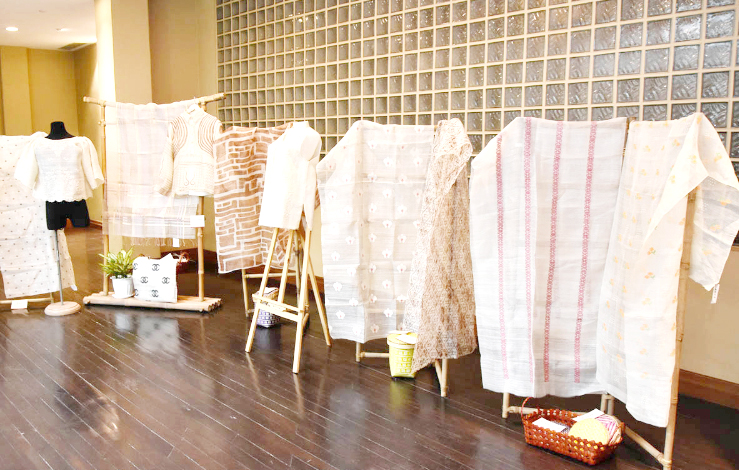Piña makes giant leap onto the world stage
Aklan's weaving tradition using pineapple fiber inscribed on UNESCO representative list of the intangible cultural heritage of humanity
By Aaron Cabeza
At A Glance
- Estimated to be about two centuries old, the weaving of the piña began soon after the introduction of the pineapple to the Philippines. An ancient art form, the process remains unchanged, almost untouched by time.

It’s among the most distinctly Filipino handwoven textiles and yet piña remains a canvas brimming with possibilities. A departure from the more common use of cotton and abaca in traditional Filipino clothing, the use of pineapple leaf fibers results in a sheer fabric with an elegant sheen, boasting an ivory hue that captivates with its delicacy and simplicity.
Cherished for its aesthetic appeal, piña serves as the primary material for formal garments like the terno and the barong Tagalog. It’s also a great material for creativity expressed in embroidery, appliqués, and painting, which is why piña is a showcase of Filipino craftsmanship, which is indispensable in its production. Many piña products are cherished as heirloom pieces, passed down through generations.
The piña made a giant leap onto the world stage recently. It was inscribed on the UNESCO Representative List of the Intangible Cultural Heritage of Humanity together with 44 other intangible cultural heritage elements from around the world on Dec. 5, because of its importance in demonstrating to the world the diversity of cultures and creative expressions of the Philippines.
Estimated to be about two centuries old, the weaving of the piña began soon after the introduction of the pineapple to the Philippines. An ancient art form, the process remains unchanged, almost untouched by time. Even technological advances have yet to intervene in this age-old craft.

The Aklanons, the people in the province of Aklan in the northwestern tip of Panay Island, part of the Visayan cluster of islands in central Philippines, are revered for producing the piña. Production is historically concentrated in the barangays of Old Buswang and New Buswang in the capital town of the province, Kalibo, as well as in nearby municipalities, such as Makato, Tangalan, Balete, Banga, and Lezo. Recently, practice of the craft spread in other areas such the provinces of Antique, Capiz, Leyte, Camarines Sur, and Palawan.
To this day, piña weaving is alive in Aklan, considered as a family and community heritage, and the knowledge and skill are passed on in traditional ways. Recently, different organizations, both governmental and non-governmental, have been providing assistance in the transfer of knowledge such as the School of Living Traditions of the National Commission for Culture and the Arts.
The production of the piña starts with the cultivation of the Red Spanish pineapple cultivar, locally called pinya Bisaya, both in the backyards of houses and in larger farms. In Aklan, pineapple farms exist in 15 municipalities—Altavas, Balete, Banga, Batan, Buruanga, Kalibo, Lezo, Libacao, Madalag, Makato, Malay, Malinao, Nabas, Numancia, and Tangalan.
After 18 to 24 months, the leaves of the pineapple plants are deemed mature enough to be harvested. Fibers are then extracted from the leaves. Using a shard of porcelain, the scraper removes the epidermis of the leaf, extracting the rough fiber, called “bastos.” To extract the finer and more valued “liniwan,” a coconut shell is run across the inner layer.
The next step, the degumming, involves repeated washing of fibers in running water, usually in rivers. Fibers are then air-dried and bundled. The amount of fiber is measured by local weighing method, using old coins of different denominations and sikapat, a local unit of measurement.
The fibers are knotted to form long, continuous strands, coiled in a clay pot to prevent tangling and spooled around bamboo bobbins. Threads are then put into a sab-ongan, or warp wheel, for desired dimensions.
The fibers are then ready for weaving. The weaver usually work at home, on a wooded upright pedal loom with two or four foot-operated bamboo treadles in a space in the house designated for weaving.
The common patterns used are the ringgue (lace weave), pili (inlaid weave), and tablero (checkered pattern), or a combination of these.
A wide range of people and workers—farmers, scrapers, knotters, warpers, weavers and also traders and designers—are bound together by piña textile making, a livelihood passed on to younger members of the communities, nurturing a sense of belonging, mutual respect and interdependence among practitioners and bearers.
The piña, an epitome of Aklanon traditional craftsmanship and articulation of native aesthetics, has become a cultural marker for the Philippines and a living heritage esteemed by the whole world.